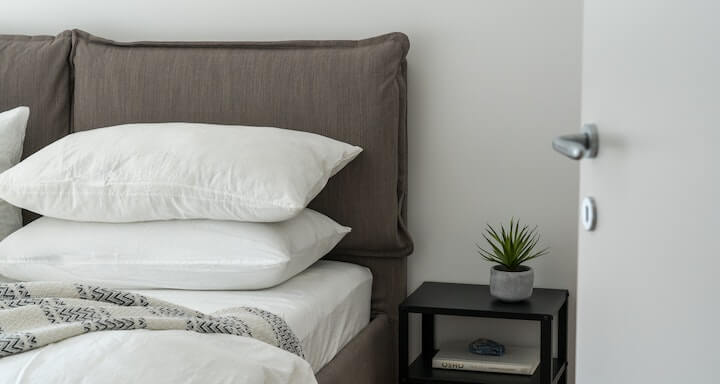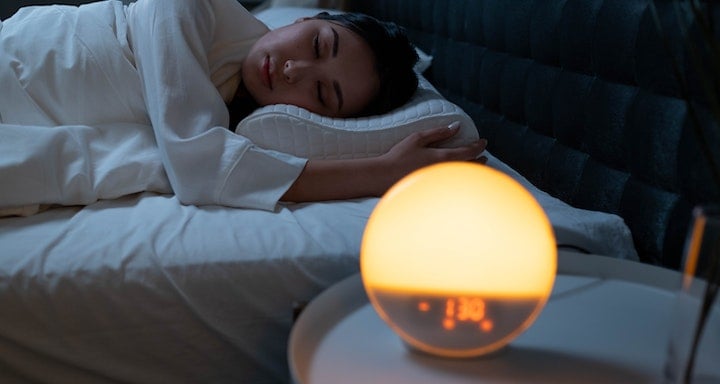Picking Your Perfect Pillow
We're all familiar with those restless nights spent tossing and turning. Throw in some uncomfortable or worn-down pillows and it's a recipe for disaster.
So, whether you're moving house and starting from scratch with some new bedding, or think it's about time to change your pillows, it's important to know how to pick the perfect pillow to support you through many nights to come.
As well as ensuring you wake up feel refreshed for the day ahead, having the correct pillows can have both physical and mental health benefits.
For example, it can help to alleviate any neck pain if it's the right supportiveness and firmness suited to you, which in turn will help you feel happier when you continuously have comfortable and quality sleep.
To help you choose the best pillow for you, we've put together this helpful guide, so you know what to look for and what to avoid when choosing your pillows. Here, we'll be covering:
- Why is it so important to get the right pillow?
- What pillow types are available?
- How to choose the perfect pillow
- -Fill
- -Fabric
- -Weight
- -Size
- -Allergies
- Other Considerations
- -How many pillows should I sleep with?
- -Your sleeping position
- -Balancing your pillow and mattress firmness
Why is it so important to get the right pillow?
Although it may just seem a place to rest your weary head at night, your pillow helps to keep your spine and neck aligned so you don't wake up with aches and pains.
For this reason, it's important that you take the time to assess your preferences and any existing concerns or injuries you might have when searching for your pillows.
If your pillows aren't right or supportive enough it can lead to misalignment between your spine, neck, head, and the rest of your body. This in turn can cause a lot of strain, which can mean a lot of sleepless nights for you, so it's worth investing in the right pillow for you.
However, note that the best pillow for you may not necessarily be the same as what your friends and family are recommending. This is very subjective, so you'll need to know what properties pillows can have and which ones might be the most suitable for you.
Below, we will be explaining what pillow types there are, as well as tips for choosing the perfect pillow for you.
What pillow types are available?
Before you begin your search for the perfect pillow, it's worth knowing what types there are available.
This way you can narrow your search before it's even begun, making your job to quickly find the most suitable pillow easier.
If we're stripping it back to basics, there are three main types of pillow: feather and down, microfibre, and memory foam pillows.
Each of these have their pros and cons, and the best one for you will depend on a number of personal factors including your sleeping position, if you have any existing neck injuries, and the firmness you like your pillows to have.
|
Pros |
Cons |
|
|
Down Pillow |
|
|
|
Feather Pillows |
|
|
Although more expensive than synthetic fibre options, feather and down pillows are an incredibly popular choice with many people.
Down, in particular, is made from either duck or goose fibres, with goose being the softer but more expensive of the two. Not only do the materials mean the pillows are soft and mouldable, but they also have a longer lifespan.
But how do you know whether you should shop for feather or down?
Feather pillows are loved for their cooling properties as they don't trap heat the same way clusters do, which means if you frequently find yourself flipping your pillow over to the cooler side, you'll no longer need to do this.
However, the feathers do tend to poke through the pillow casing which can be uncomfortable for some.
With down pillows, you don't get anything protruding through the pillows, however, they will retain more heat, which may not be suitable for those who typically get hot during the night.
Additionally, unlike other pillow types, down and feather versions can't be washed at home and need to be professionally cleaned. If these are issues for you, you might be best off choosing microfibre or memory foam pillows.
2. Microfibre Pillows
|
Pros |
Cons |
|
|
Mircofibre Pillow |
|
|
Microfibre pillows are another very popular pillow choice among customers. With a wide range of benefits, including being hypoallergenic, lightweight, and affordable for all budgets, microfibre is a sensible route to explore if you're looking to replace or buy many pillows to go in your home.
In addition to the above, microfibre have the benefit of being able to be washed at home. Plus, as they come in a variety of different shapes and sizes, you can ensure you get the right pillow, no matter if you're a side, back, or front sleeper.
As with all other pillow types, there are some downfalls to buying microfibre. For example, the affordability does affect their quality to some extent, meaning you'll need to change these more often than feather and down and memory foam alternatives.
Similarly, the filling isn't as breathable or mouldable as other versions, which could be an issue for those who have a room that tends to feel hot and stuffy on a night.
3. Memory Foam Pillows
|
Pros |
Cons |
|
|
Memory Foam Pillow |
|
|
Reigning champion for most supportive are memory foam pillows.
These are ideal for those who get neck pain and need something to cradle their head and neck as they sleep.
The properties within memory foam mean it can mould to your head, no matter what your sleeping position is, and then spring back to its original position when you make your bed for the day.
This makes memory foam an incredibly long-lasting option, however due to the newer technology used within them, they are understandably a little more expensive than microfibre and down and feather alternatives.
It's easy to take care of memory foam pillows, however, depending on your preference, you may find them too dense and in summer they can be too hot to sleep on.
It's worth noting that there are some revolutionary sleep technologies that combine memory foam with cooling properties to tackle this problem. You can find these kinds of pillows in our Octasmart pillow range.
Other Pillows to Consider
Although the above three pillow fillings are the most popular, there are a couple of others you may want to consider before starting your search.
|
Pros |
Cons |
|
|
Latex Pillows |
|
|
|
Wool Pillow |
|
|
|
Cotton Pillows |
|
|
Latex pillows are one of the least common choices due to their higher cost, however they have plenty of benefits to outweigh the price.
This includes offering great support, being breathable and being naturally hypoallergenic. Plus, they can also mould to your head and neck, like memory foam does, to ensure you're comfortable and supported through the night.
Wool and cotton pillows are naturally resistant to the presence of dust mites, meaning they're great for those who have allergies. They are also breathable and cool so you will stay comfortable during the night.
However, they can lose their shape quite easily and can be heavy.
How to Choose the Correct Pillow
The correct pillow will differ from person to person, and as well as considering the above types, there are a couple of other factors you may want to know about before you begin browsing for your new pillows.
Fill
As discussed in the pillow types section, you'll need to think about what filling best suits you.
A good way of doing this may be to write down your top three priorities that a pillow must be, and then see which filling type matches up to this best. You can use the summary tables we created for feather and down, memory foam, and microfibre to help you do this.
For example, if you write down affordable, hypoallergenic, and supportive, a microfibre one might be the best option for you.
However, if you choose to prioritise support and are willing to spend a bit more, memory foam would be a great option.
Even if you don't have a known allergy, it may be smart to err on the side of caution and get something synthetic to avoid running the risk of a reaction.
Fabric
The fabric on the outer of the pillow should also be taken into account as this can contribute to allergies or skin reactions, plus there are some that are much more breathable than others.
Even though you'll be putting pillowcases on top of them, you need to ensure you get the right type of fabric outer to suit you.
Some of the most common fabrics used for pillows include cotton or linen, as they are breathable, durable, and easily washable.
Plus, as these are both natural fibres, they are kinder to skin than synthetic alternatives may be, meaning you're sure to love sleeping on them.
Weight
If you're thinking about choosing down or feather fillings for your pillows, it's worth knowing that they come in a range of available weights, which are dictated by the amount of down inside of them.
The more down there is, the firmer and higher quality your pillow will be — but note, this will also dictate how expensive it'll be.
So, if you're looking for something on the softer side, you'll want to go for a lower fill than you would if you were in need of a much firmer pillow.
Softer pillows may have a fill weight of around 3oz, whereas the firmest ones could weigh up to 40oz.
However, be aware that these fill weights can differ between brands, and bear in mind that having more fill power doesn't always equate to them being the most durable choice.
So, take the time to study each retailer's fill weight guides, as well as speaking to the experts who work there.
And, of course, don't forget to trial enough types to find your perfect pillow.
Some places will have a money-back guarantee in place where you can buy and test the product for a set period and if you're not fully satisfied with it, you can return it and have your money back.
Size
The standard pillow size in the UK is around 50cm x 75cm, and, for most people, this is large enough to get a comfortable night's sleep with.
However, the preferred size of your pillow is completely up to you, you'll just need to make sure any bigger or smaller sizes adequately keep your posture in alignment.
Note that the thinness or thickness can dictate your posture when you sleep, too. So, make sure to pick one that will keep your posture straight as you sleep, so you don't wake up with aches and pains.
Allergies
Some pillows will be unsuitable for those who have allergies.
For example, down and feather pillows can exacerbate asthma and respiratory problems, as well as irritating sensitive skin.
If you do know you're allergic or sensitive to some fills, you may want to choose alternatives such as memory foam or microfibre.
You can even buy hypoallergenic pillows or bedding bundles now to keep those allergies at bay while you sleep, meaning you get a more restful night.
If you struggle to get to sleep because of allergies, why not check out our top 10 tips for creating an allergy-free bedroom? You're sure to find some practical tips to help you rest easier and more comfortably at night.
Other Considerations
How Many Pillows Should I Sleep With?
The number of pillows you sleep with is very subjective, however sometimes having a certain number of pillows can help to alleviate some issues.
For example, if you get neck pain, it's sometimes better for you to only have one slimmer pillow so that your neck and spine are better aligned, rather than half of you being more raised than the other.
On the other hand, if you're suffering with breathing difficulties, sleeping with two pillows can place you in a slightly propped up position to help open up your airwaves a bit more.
If you have a partner who snores, ensuring they sleep slightly elevated can help keep this to a minimum as their airwaves will be less compressed when lifted.
Whether you sleep one or two is completely up to you, but if you do feel pair or struggle with the current amount, try changing and seeing how you feel.
As a limit, you shouldn't sleep with more than two pillows because it can cause misalignment of your spine, neck, and rest of your body, which could result in aches and pains you didn't have before or could worsen existing problems.
Your Sleeping Position
The position you sleep in is an important factor to consider when selecting a pillow as each type of sleeper will need support in different areas.
For example, those who sleep on their back may need medium or high loft pillows to keep their neck and head elevated. You can find more information about this in our guide to the best mattress and pillows for back sleepers.
In contrast, if you prefer to sleep on your front, you'll need to pick a pillow that's as thin as possible while still providing support.
This is because having something with too high of a loft can cause misalignment between your head, neck, and spine.
It can be slightly trickier to buy the right pillow for front sleepers, however we put together a handy guide to the best mattress and pillows for front sleepers to help you find the perfect one for you.
The most common sleeping position is on the side of the body.
However, if the gap between your head and the mattress isn't filled with a supportive pillow, it can lead to bad neck pains and mean your spine is out of alignment.
If this is your preferred sleeping position, we recommend reading our guide to the best mattress and pillows for side sleepers.
Balancing Your Pillow and Mattress Firmness
One other important factor you may want to consider when choosing a pillow is how the firmness of it will feel against your mattress firmness.
For example, if you've got a bad back and therefore have a firm mattress to keep your spine aligned during the night, you could get a pillow with medium firmness to ensure you're still comfortable while remaining supported.
On the other hand, if you've chosen a mattress on the much softer side, your pillow may need to be balanced with this so you don't totally sink into the bed as you sleep, as this can cause misalignment.
This may mean you'll need to get a firmer pillow that will keep your head and neck supported.
Picking the perfect pillow can seem a daunting task at first, with so many retailers offering many different kinds. But, with the tips in this guide, you should be well-informed to begin your search for the best pillow for you.
Just remember, any pillow you pick will need to be suited to your sleeping position, and address any concerns you may have including allergies, filling, and weight.
With pillows, there can be so much to consider, but don't forget about the importance of bedding in general.
Here at Dormeo, we specialise in memory foam mattresses, mattress toppers, pillows, and bedding, so you can guarantee we have the cosy addition for your bed here. We have plenty of ranges for you to shop, which all have unique features and properties.
For more helpful advice and sleep tips, make sure you check out our guides and our blog. If you have any questions about our products, or want some help choosing the best mattresses, pillows or bedding, don't hesitate to get in touch with our expert team.







